Source: CCTV.com
08-02-2006 16:45

"Hello welcome to Travelogue, I am Liu Changying. In this episode we continue our Street Special here at Nanjing: the literal meaning of the Southern Capital, as opposed to Beijing, the Northern Capital. Let's wander on the streets of Nanjing. Welcome to Nanjing."
Boasting a prestigious imperial past, serving as inspiration for many poets, the city of Nanjing is the place where you can get really close to history, I mean really really close. It sits on the lower reaches of the Yangtze river, a strategic position of such importance that six ancient dynasties had made Nanjing its capital. Today Nanjing is the sprawling capital of Jiangsu province, with a population of over six million people.
We are going to show you Nanjing through three special streets, the Yudaojie Street, the Changjiang Street, and the Gaochun old Street, which is over 1.5 hour's drive from downtown Nanjing.
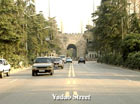
That is Yudaojie, the Royal Pathway. During Ming Dynasty, before the emperor moved the capital north to Beijing, Nanjing was the capital and the emperor built the city walls and imperial palace here. All the important military, high court and other department lined along that street. Now we've just entered Wumen, which means the Meridian Gate.
The six-meter wide stone pavement was only reserved for the emperors and the high-ranking officials. That means only the emperors could use that gate.
Entering Wumen, you leave behind the traffic of modern times and enter the Imperial City of the Ming Dynasty. Inside the Gate of Wumen is another small open-air museum where people keep a small garden-like space to display some of the stone architectural elements.
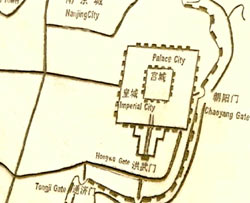
This is Yudaojie, the Royal pathway street. And this is the royal palace and the imperial city, but unfortunately they are long gone, but much of the outer city wall still remains standing. Here we are, a little corner beside the famous Mochou Lake.
The wall was built along a natural river, which served as the moat for the city. That side is outside the wall and over there is inside the city. Today the city of Nanjing has grown out of the city walls, but isn't it nice to have such ancient walls inside your city? What a treasure.
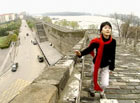
After over 600 years these stonewalls still stand here silently as valid witnesses to the passing of time. The outer city wall is acclaimed as the longest city wall in China. It stretches over 33 kilometers and most of its parts still remain standing amid the city of Nanjing, though the face of the city has long changed.
Today, with high rises and skyscrapers, the skyline of Nanjing has changed much.
Just like any other city around the country, the old alleyways are disappearing quickly. But if you look carefully, you can still find one or two left. Along which, fine spots that give you a sense of how life used to be like around here.

I've just entered Ganjiadayuan, former residence of the Gan family. The huge compound wasn't built in one day, but was gradually expanded over years through several generations. The most famous figure in the family is a man named Gan Xi, a scholar of Qing Dynasty. The massive wooden decoration and the scale of the residence telltales the affluence of the family.
People in Southern China love to pave their courtyard with all kinds of patterns with pebble stones or bricks. In this courtyard it's paved with a special kind of bricks. But it's not done in the usual way we know, with the brick laying on the ground, but rather with the brick standing like this. More than that, the yard never flooded during the summer because it has a wonderful drainage system, which was designed before the yard was built. Some people say it’s even better than what we use today.
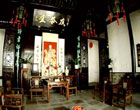
The Gan residence has a total of over 300 rooms, but people only say it has 99.5 rooms. Why? One explanation is that during the Qing dynasty, nobody was supposed to own a home with over 100 rooms, except the royals. So no matter how large you made your home, you could only say you had 99.5 rooms. Thus the name "ninety nine and a half" has become the name for many similar grand home complexes. Basically it is composed of many small courtyards that are linked with one another.
Pushing a window open, I tried to picture a life here: it was a time when girls were not supposed to leave the courtyard, especially the girls from a rich, influential family like this. And the narrow alleyways were once busy with hurriedly running errands.
The Gan family was particularly known for their artistic talent. By the end of the Qing Dynasty, it's said each of the couple hundred of the family members could play a musical instrument and one of their favorites was a local opera called Kunqu.
Even today people still came here to practice Kunqu. They call themselves Friends of Kunqu.
These amateur Kunqu singers meet here every weekend in the old residence. I was surprised to find one foreign face among them.
Kunqu is one of the finest and oldest forms of local operas in China. Somehow the slow melody just matches the old houses and rooms, which are full of untold memories and stories.
For a taste of the local flavors, one recommendation is the Shiziqiao Street, in conjunction of Hunanlu Street. It is my policy to try the most indigenous local food wherever I go. For that reason, the Nanjing Dapaidang restaurant is one good choice. Its deliberate antique decorations as well as the furniture indicate a clear vow to provide a flavor that is one hundred percent local.

There are so many choices, but I can only recommend a few here we are. This is Shizitou, very easy to remember, the head of a lion. This one is the root of the lotus. This one is Luhao, vegetable only available in this part of China and the last one, this one I've never heard of, it's called Tang Yumiao, sweet little taros.
Early morning is the time a city reveals its natural beauty, before it disguises itself in the artificial makeup of traffic jams and noisy crowds. That's why I chose to get up early to do some jogging, to get a glimpse of the local life in Nanjing.
But jogging is probably the most boring exercise in Nanjing. This little bamboo toy is called Zhumingtang. It stimulates your waists, arms and even your ears.

And the prize for most beautiful sight still goes to the wonderful practice of the Taiji sword. You can find groups of people practicing along the road. Obviously you don't get this good with only one or two days of practice. Some of them have been honing their skills for over decades. It is interesting just to watch them move peacefully along the increasingly busy streets.
Another thing you won't miss noticing along the roads are those folks who gather to give their birds a fresh breath of air in the morning. These birds are carefully pampered and taken care off. And their owners are all too familiar with the birds' habits, what they are afraid of, what they really like.
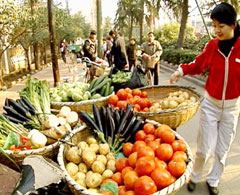
The morning market usually only opens along the Yudao Street between 6:00 and 7:30. The farmers nearby come to sell their fresh vegetables and other household items.
It's cheap and fresh.
The old saying that the early bird gets the worm holds true here in describing the roadside food stands. Different stands provide different choices for breakfast. This is the Chinese version of fast food. Convenient, a multiple of choices, and ready in an instant, such food stands are a blessing for anyone hurrying on their way to work. Such little Wantons, with just a teeny tiny little amount of finely ground pork wrapped inside paper-thin dumpling skin, are unique to the region. And believe me, they are pretty tasty.
Even in the winter's time, the streets in Nanjing still look pretty. Aged Wutong trees, or the Chinese parasol trees, stand neatly along the roads, like well-disciplined soldiers dutifully guarding the city. However, walking on the modern street of Nanjing amidst the traffic, it's hard to imagine the city's former glory.
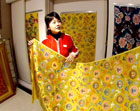
I went to the Nanjing Bowuyuan, or Nanjing Museum, to find one thing that most colorfully represents the past: the wonderful Yun brocade. Yun means cloud and the Yunjin literally means a brocade as beautiful as the cloud. At the museum, Mr. Jin Wen kindly serves as my tour guide to give me a rudimentary explanation about the complex ancient skills.
Ordinary people wouldn't have the luxury of even looking at them. Because it's the royal supply, there are particular rules regarding the design and the color of each piece of brocade, which was were entitled for specific usages.
The weaving procedure is complicated even to look at. Want to know how complicated it is?
One day's non-stop work can only produce only five centimeters of brocade.
Not only do people care about the colors and the shine of the fabric, but even the sound the skirts make counts.
Host: "Imagine how I sound if I worn a dress like this and walked by?"
Together with reviving the old skills, Jin Wen also renovates the old patterns of Yun brocades to suit modern tastes. His studio even produces brocades with styles and designs that cater to the westerners' eyes.
Nanjing has served as the capital for 10 different governments and administrations, including six ancient dynasties. The last one is the Guomingtang government and many of the buildings from that period still stand along the Yangtze road, which was named after the famous Yangtze River, marking a special time span in China's history.
You could still find many buildings from that period, a time when the western influences, including the notion of democracy and science gradually swept into the Middle Kingdom. The changes of the mindset were reflected in the changes of architectural style. It was a most turbulent period of time in China when the country was torn with civil war and countless revolutions.
The Changjiang road bore witness to one of the most important moments in China's modern history: when the PLA took over the Presidential Palace, marking the defeat of the Guomintung government, headed by Jiang Kaishek, who had won the title through a series of political tactics, and had by then lost the trust of the Chinese general public.
However, the Presidential Palace also commemorates a well-respected President, the first president in China's history.
On January 1 1912, 10 o'clock in the evening, it was at this particular point that doctor Sun Yat-san was sworn into office. After a short and simple speech, he became the first president of China, marking a new period in China's history.
Although Dr. Sun remained in office only for a very short time, 91 days, his presidency marked the end of the thousand yearlong feudal system in China.
Before it served as president palace, the garden was the home of some Qing Dynasty officials. It's hard to believe the important history of modern China took place in such a delicate garden. And this building is where Dr. Sun Yatsan lived during the 91 days he served as president of China.
Dr. Sun Yat-san was so well respected that after his swear in many Chinese, home and abroad were overjoyed by the news. Some Chinese living abroad sent him some gifts to congratulate him. These two are for one to keep gold fish.
As night falls, it's even easier to fall back in time. Today, people mix the past and the present to build this trendy place, an area known as Nanjing 1912. Sitting right next to the Presidential Palace, you can find all kinds of bars, coffee shops, restaurants and clubs. It is the newest hot spot to be seen at night.
I am impressed with the wide avenue of Nanjing. Now we are here to visit an old street of Gaochun. Let's see what the township street used to be like.
The streets here are very much different from the avenues in Nanjing. The basic structure of the street and buildings along the road still serve the same purpose they did in the old time. The doors that could be unloaded make sure that the shops are completely open to customers.
From the doors you can tell what these shops were intended for originally. The wooden doors indicate it was a shop where people could come in, look around, and buy whatever they needed but the doors with stone frames meant that it used to be a workshop, producing items such as soy sauce powder. These two openings were for carts that brought the goods inside. And the animal that pulled the goods in would be tied here outside.
Most of the people living on this street make a living out of tourism, selling all kinds of souvenirs to visitors. This is a small workshop that produces a kind of sweet cake made from rice powder. The freshly made ones are especially tasty and moist.
I am looking for an ancient well on the street, here it is, and they have a sign for it.
Ha the trick is that you need to swing the buckets hard to get water into it. And you see these marks, they come from years of people pulling water out of the well. Now, the water from the ancient well. People still use it to wash vegetables and clothes. You are not supposed to pour the water back into the well, so I am going to, hmm, water some plants.
Many of the buildings bear a unique signature local architectural feature, a drum like decoration called Xigu.
The old street is like a museum, but it has its own museum. This one displays the gods of Taoism, each one represented a star.
Followers of Taoism study mystic sciences such as astrology and alchemy. Each of these gods has his, or her, own characters and duties. For example, the north star of Xuanwu is represented by a bull. And the goddess of the moon is supposed to be in charge of marriage. Besides the stars, the religion has a myriad of gods that are much forgotten in the modern days. It’s a surprise to find so many of such precious relics carefully preserved in the small town. The collection here is, supposedly, the largest one of its kind in China.
Also on display in this small museum are a number of well-done stone wood, and bricks. They were collected from nearby villages or just on this old street of Ganchun.
It’s hard to get the true essence of a place just by a swirl-like visit, not even a small street like the Gaochun, not to mention the big city of Nanjing. But somehow I think I’ve managed to grasp a little bit of it and I hope you can experience it as well watching our show.
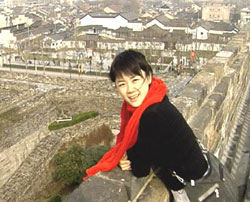
There is nothing exotic and exciting about Nanjing. It’s all peaceful and traditional and historical. Yet I fell in love with it after just a few days. It is said that Nanjing is very hot during the summers, but I will definitely coming back for the summer to see the streets covered with lively green leaves. This is the Travelogue Street Special in Nanjing, I am Liu Changying, I will see you around.
Editor:Chen

